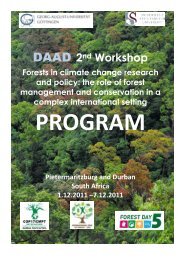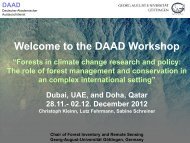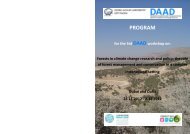Proceedings of the Workshop - Georg-August-Universität Göttingen
Proceedings of the Workshop - Georg-August-Universität Göttingen
Proceedings of the Workshop - Georg-August-Universität Göttingen
You also want an ePaper? Increase the reach of your titles
YUMPU automatically turns print PDFs into web optimized ePapers that Google loves.
2.3.5. Payments for environmental services (PES)<br />
The Costa Rican government compensates landowners for important ecosystem<br />
services provided by forests and forest plantations on <strong>the</strong>ir property by implementing a<br />
payment for environmental services program (PES).<br />
This mechanism is regulated by national law and provides financial incentives for<br />
GHG mitigation, watershed protection, and biodiversity conservation, among o<strong>the</strong>rs,<br />
through <strong>the</strong> National Fund for Forestry Financing (FONAFIFO 2010).<br />
Currently, <strong>the</strong> amounts to be paid for environmental services range from $US 1.3<br />
per newly planted tree in agro forestry systems in a period <strong>of</strong> 3 years, to $US 980 per<br />
hectare in a period <strong>of</strong> 5 years for reforestation (Costa Rica, 2010).<br />
During <strong>the</strong> AMISCONDE project, <strong>the</strong> participation <strong>of</strong> farmers in <strong>the</strong> national PES<br />
program was promoted, in order to maximize <strong>the</strong> benefit that producers could gain from<br />
conservation efforts on <strong>the</strong>ir farms. We initiated an information campaign within <strong>the</strong><br />
communities and <strong>the</strong>n recorded all interested persons who were eligible for <strong>the</strong><br />
program. The farmers were supported throughout <strong>the</strong> necessary registration with<br />
FONAFIFO, <strong>the</strong> documentation <strong>of</strong> legal requirements and we fur<strong>the</strong>r facilitated<br />
technical advice by an accredited forest engineer who monitored and certified <strong>the</strong><br />
entire process.<br />
Finally, farmers who met all requirements, signed a contract with FONAFIFO in<br />
which <strong>the</strong>y pledged to plant and maintain a defined number <strong>of</strong> trees in <strong>the</strong>ir<br />
agr<strong>of</strong>orestry systems, as established in <strong>the</strong> implementation plan previously elaborated<br />
by <strong>the</strong> forest engineer with <strong>the</strong> approval <strong>of</strong> <strong>the</strong> land owner.<br />
3. Results and Discussion<br />
3.1. Environmental Education Program<br />
Regarding <strong>the</strong> training sessions, one may conclude that a learning-by-doing<br />
approach was more successful than formal instruction, as appreciated in <strong>the</strong> field,<br />
where farmers put in practice what <strong>the</strong>y had learned.<br />
Four classrooms were built during <strong>the</strong> project to provide a sustainable option for<br />
<strong>the</strong> environmental education activities. Currently <strong>the</strong> environmental community<br />
organizations are responsible for <strong>the</strong>se classrooms by securing financial support<br />
through different donors in <strong>the</strong> region or promoting different fund-raising activities.<br />
Environmental festivals attracted local governments, NGO's and o<strong>the</strong>r<br />
organizations with political impact in <strong>the</strong> region, who took <strong>the</strong> opportunity to promote<br />
<strong>the</strong>ir conservation activities in <strong>the</strong> area and streng<strong>the</strong>n <strong>the</strong> cooperation efforts between<br />
different partners.<br />
One key aspect observed throughout <strong>the</strong> project that should be taken in<br />
consideration by any development project is <strong>the</strong> capacity-building issue. Using local<br />
organization for <strong>the</strong> training ensured that currently, even though <strong>the</strong> project is no longer<br />
in place, local organizations continue to deal with some <strong>of</strong> <strong>the</strong> issues set forth by <strong>the</strong><br />
project.<br />
3.2. Biological connectivity<br />
A total <strong>of</strong> 7 438 hectares within <strong>the</strong> region <strong>of</strong> <strong>the</strong> project were selected as an area<br />
<strong>of</strong> biological connectivity (Canet 2003). Identifying <strong>the</strong>se areas ensures <strong>the</strong> positive<br />
impact on <strong>the</strong> protected area, where design elements <strong>of</strong> landscape ecology were taken<br />
in consideration.<br />
The focus <strong>of</strong> this selection <strong>of</strong> connectivity areas generated positive impacts: <strong>the</strong><br />
amount <strong>of</strong> reforested areas (more than 2 000 ha), capacity-building and instruction<br />
‐ 38 -










